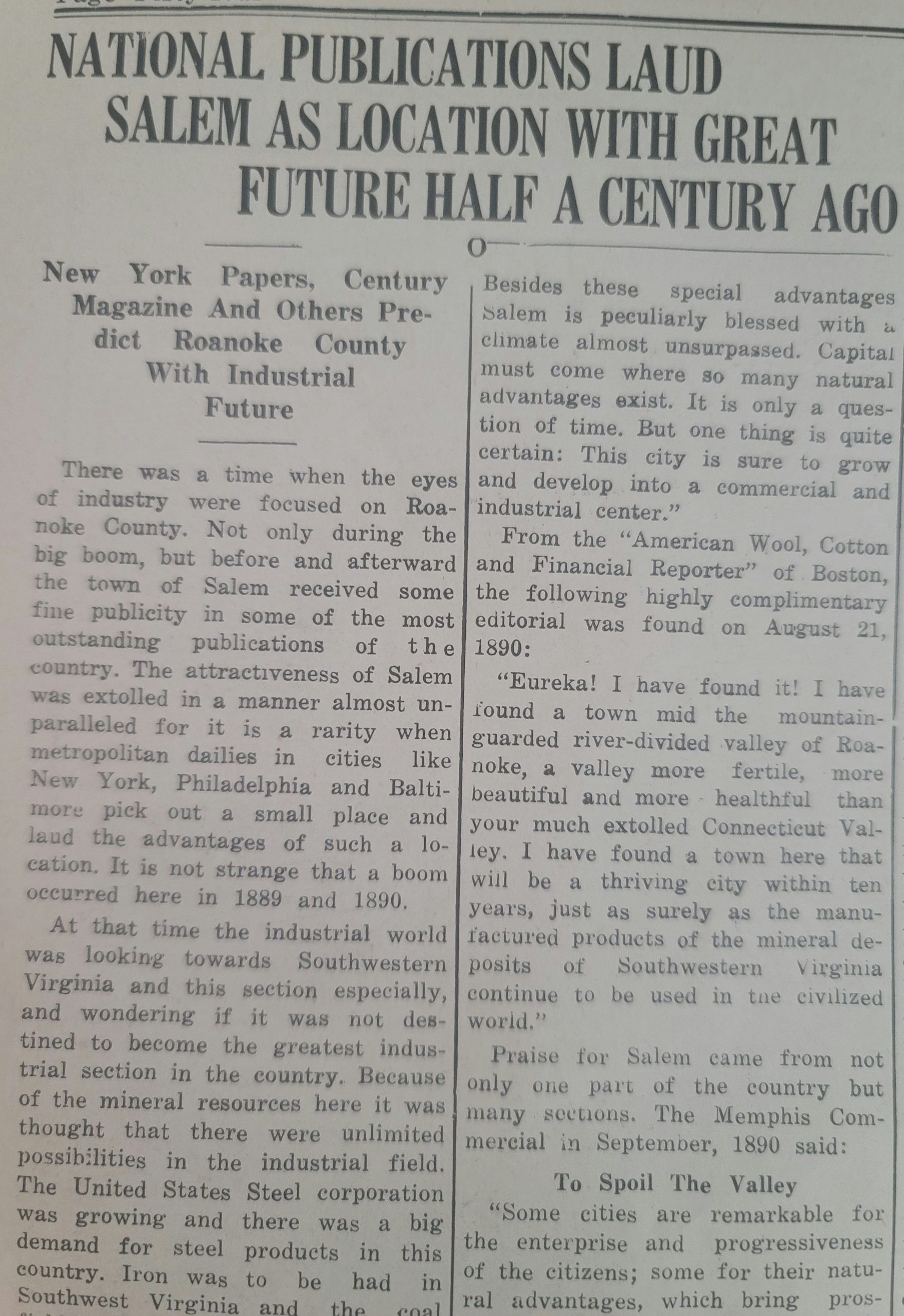
New York Papers, Century Magazine And Others Predict Roanoke County With Industrial Future
From the 1938 centennial edition of The Times-Register
There was a time when the eyes of industry were focused on Roanoke County. Not only during the big boom, but before and afterwards the town of Salem received some fine publicity in some of the most outstanding publications of the country. The attractiveness of Salem was extolled in a manner almost unparalleled for it is a rarity when metropolitan dailies in cities like New York, Philadelphia and Baltimore pick out a small place and laud the advantages of such a location. It is not strange that a boom occurred here in 1889 and 1890.
At that time the industrial world was looking toward Southwestern Virginia and this section especially, and wondering if it was not destined to become the greatest industrial section in the country. Because of the mineral resources here it was thought that there were unlimited possibilities in the industrial field. The United States Steel corporation was growing and there was a big demand for steel products in this country. Iron was to be had in Southwest Virginia and the coal fields were not far away.
Iron Ore Played Out
However, the iron ore deposits in Northern Minnesota proved to be of a higher grade than the Virginia deposits so that the steel companies turned toward that section for their raw material. If the iron mines here had proved to be of great value, it is probable that this section of the state would have turned out to be the greatest industrial section of the nation and of the world.
From many sources came praise for the natural advantages of Salem as a residential town, a manufacturing center, an agricultural center together with much favorable comment upon the healthful climate conditions here.
The Century Magazine of April 1874 said: “Climbing over the huge grades of the Alleghanies, we came suddenly upon the delicious expanse of the Roanoke Valley, bathed in the splendid shimmer of the afternoon autumn sun, and faded into delicatest colored shadows where the mountain rose gently, as if loathe to leave the lovely and lowly retreat. The vale was filled with wheat and corn fields, and with perfect meadows, through which ran little brooks gleaming in the sun…. Salem, the site of Roanoke College, is surrounded by charming hills, and stands in one of the richest agricultural regions in the United States.”
No Scandals Here
From the Hartford Courant of 1883 we read the following:
“Salem has more natural advantages as to health, sightliness, fertility, and picturesqueness, perhaps than Roanoke. It seems to be a salubrious place; its water supply is from one of the remarkable mountain springs of which I have spoken; the meadows are rich, the air is pure and sheltered by the hills, it has a temperate climate with little snow. This outline is enough to show that the region is one of great natural beauty. Observation leads us to say that it is the abode of a hospitable, industrious and highly moral people. It is a town where the domestic virtues thrive and there are no scandals.”
Said the New York Evening World on November 18, 1889:
“Salem presents attractions as a place of location that no other town along the route can offer. From the time of its birth Salem has had just recognition as a place of true refinement and culture. Possessing as it does, a beautiful location, perfect drainage and healthfulness which is proverbial, Salem is sure to be within a few years, on account of these natural advantages, a large and important city. No place offers more attractions to manufacturers or men with brains and capital.”
Not to be outdone by its contemporary, The New York Sun gave Salem some most favorable publicity on Jan. 18, 1890, when it said:
“Salem holds out many inducements for the capitalist, investor and settler, chief of which is its peculiar central location with reference to the large territory which can be supplied in all lines of manufacturing and trades of all classes. It is located in the rich iron ore, coal, limestone and timbered country, embracing all kinds of timber, which, with the present facilities of transportation can be placed in Salem at low rates and small cost. Besides these special advantages Salem is peculiarly blessed with a climate almost unsurpassed. Capital must come where so many natural advantages exist. It is only a question of time. But one thing is quite certain: This city is sure to grow and develop into a commercial and industrial center.”
From the “American Wool, Cotton and Financial Reporter” of Boston, the following highly complimentary editorial was found on August 21, 1890:
“Eureka! I have found it! I have found a town mid the mountain-guarded river-divided valley of Roanoke, a valley more fertile, more beautiful and more healthful than your much extolled Connecticut Valley. I have found a town here that will be a thriving city within ten years, just as surely as the manufactured products of the mineral deposits of Southwestern Virgina continue to be used in the civilized world.”
Praise for Salem came from not only one part of the country but many sections. The Memphis Commercial in September 1890 said:
To Spoil The Valley
“Some cities are remarkable for the enterprise and progressiveness of the citizens; some for their natural advantages, which bring prosperity; and still others for a charming situation in the midst of many beautiful scenes of nature. Salem is remarkable for all of these, and he who interests himself here, either for pleasure or profit can but bless the day of his so doing.”
On April 25, 1891, the Baltimore Journal of Commerce expressed regret that the fertile valley in which Salem is located would be filled with the smoke, the dust, the noise and strife of industry within ten years. The charming valley was about to be spoiled, it was said.
Not all of the fine things about Salem were published by out-of-state publications for the Richmond Dispatch said:
“If the future of Salem as a great industrial center is not assured, then hundreds of men of sagacity and capital are blind. To see Salem is to be satisfied, that nothing has been said regarding its present, or predicted touching its future, is exaggerated.”
Dozens of other editorials along the same line could be reprinted from New England and Atlantic Coast states but all of them were along the same line. The scenic beauty, the fine climate, the great natural resources of the vicinity were stressed.
-Prepared by Lisa King





